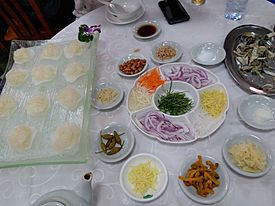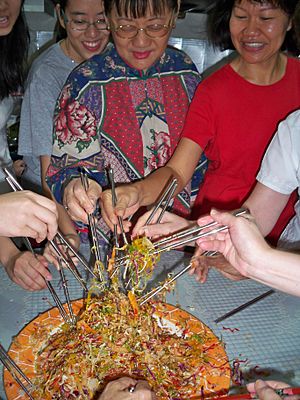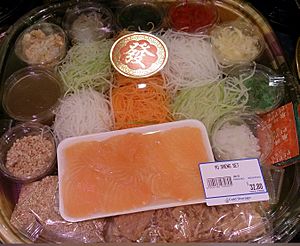Yusheng facts for kids

Yusheng with ingredients and dip sauces
|
|
| Alternative names | Lou Sang, Yee Sang, Yu Sheng, Jyu4 Saang1, Lo Hei, Prosperity Toss |
|---|---|
| Region or state | East and Southeast Asia |
| Associated national cuisine | Singapore, Indonesia, Malaysia |
| Main ingredients | Raw fish (or soy fish for the vegetarian version), shredded vegetables and a variety of sauces and condiments |
| Other information | Consumed during Chinese New Year (Only in Singapore and Malaysia) |
Yusheng, also known as yee sang or Prosperity Toss, is a special Cantonese-style raw fish salad. It's a popular dish eaten during the Chinese New Year celebrations.
This salad usually has thin strips of raw fish, like salmon. It's mixed with colorful shredded vegetables and different sauces and spices. There's even a vegetarian version that uses soy "fish" instead of real fish.
The name "Yusheng" means "raw fish." But the word for "fish" (魚) sounds like the word for "abundance" (余). So, people see Yusheng as a symbol of lots of good things, like wealth and energy.
This dish came from China a long time ago. However, the modern version we see today became popular in the 1960s. Four chefs in Singapore helped make it famous. They were known as the "Four Heavenly Kings" in the restaurant world. Because of them, eating Yusheng became a big part of Chinese New Year in Singapore.
Today, the most common type is called qicai yusheng, which means "seven-colored raw fish salad." It's served in restaurants during the Chinese New Year period. This salad often includes shredded white and green radish, carrots, ginger, peanuts, and a mix of sauces.
Eating Yusheng during Chinese New Year is a fun tradition. It's celebrated by Chinese communities in Singapore, Indonesia, Malaysia, and Hong Kong.
Contents
Where Did Yusheng Come From?
The tradition of eating raw fish during Chinese New Year started in Guangdong, China. Chinese people who moved to Southeast Asia brought this tradition with them. However, the old raw fish dishes were quite different from today's Yusheng.
Different Stories of Its Beginning
There are different ideas about where the modern Yusheng dish truly began. Some newspapers in Malaysia say it was invented by a Chinese restaurant called Lu Zhen Ji in Seremban, Malaysia. The owner said the idea came from a fish noodles dish in China.
However, people in Singapore believe the dish started there. They say the four famous chefs invented it in a Singaporean restaurant. Even the family of Lu Zhen Ji has said it's hard to prove their claim because old records are missing.
No matter where it truly started, everyone agrees that this dish has its roots deep in Southern China.
Ingredients and Their Meanings
When Yusheng is placed on the table, people say special New Year greetings. Here are some common phrases:
- 恭喜发财 (gong xi fa cai) means "Congratulations and be wealthy."
- 万事如意 (wan shi ru yi) means "May all your wishes come true."
Each ingredient added to Yusheng has a special meaning:
- Fish: The word for "fish" (魚) sounds like "abundance." Adding fish means you wish for "abundance through the year."
- Pomelo or Lime: Adding these fruits brings good luck and happiness.
- Pepper: Sprinkling pepper is a wish to attract more money and valuable things.
- Oil: Pouring oil in a circle means you want money to flow in from everywhere. It's like wishing to make lots of profit.
- Carrots: Carrots are added for good luck. The red color of carrots sounds like the word for "good fortune approaching."
- Green Radish: This symbolizes staying young forever.
- White Radish: This means you wish for success in business and promotions at work. It's like saying "progress at a fast pace."
Final Touches for the Dish
After the main ingredients, the special toppings are added:
- Peanut Crumbs: These are sprinkled on top, wishing for your home to be filled with gold and silver.
- Sesame Seeds: These mean you wish for your business to do very well and grow.
- Plum Sauce: This sweet sauce is poured over everything. It's a wish for life to always be sweet and happy.
- Deep-fried Flour Crisps: These look like golden pillows. Adding them means you wish for your whole floor to be covered in gold.
The modern Yusheng dish can have many ingredients. It often includes raw fish (like wolf herring or salmon), different radishes, carrots, ginger, peanuts, sesame seeds, and a special sauce made with plum sauce and sesame oil.
How to Serve Yusheng
Yusheng is often the first dish served at a big Chinese New Year dinner. It's eaten as an appetizer because it symbolizes good luck for the new year. Some people eat it on Renri, the seventh day of Chinese New Year. But you can enjoy it any day during the New Year period.
First, the basic ingredients are placed on the table. Then, a leader or server adds each ingredient one by one. As they add each item, they say a special "auspicious wish." For example, when adding the fish, they might say "may there be abundance year after year." This is because the word for "fish" sounds like "abundance."
After all the ingredients are added, everyone at the table stands up. They use their chopsticks to toss the shredded ingredients high into the air. While tossing, they say more good wishes out loud, or simply shout "lo hei, lo hei!" People believe that the higher you toss the ingredients, the more your fortunes will grow. So, everyone tries to toss with lots of energy!
See also
 In Spanish: Yusheng para niños
In Spanish: Yusheng para niños



